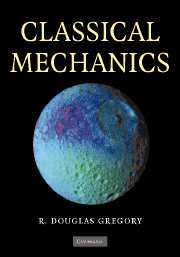Book contents
- Frontmatter
- Contents
- Preface
- 1 Newtonian mechanics of a single particle
- 2 Multi-particle systems
- 9 The energy principle
- 10 The linear momentum principle
- 11 The angular momentum principle
- 3 Analytical mechanics
- 4 Further topics
- Appendix Centres of mass and moments of inertia
- Answers to the problems
- Bibliography
- Index
11 - The angular momentum principle
Published online by Cambridge University Press: 05 September 2012
- Frontmatter
- Contents
- Preface
- 1 Newtonian mechanics of a single particle
- 2 Multi-particle systems
- 9 The energy principle
- 10 The linear momentum principle
- 11 The angular momentum principle
- 3 Analytical mechanics
- 4 Further topics
- Appendix Centres of mass and moments of inertia
- Answers to the problems
- Bibliography
- Index
Summary
KEY FEATURES
The key features of this chapter are the angular momentum principle and conservation of angular momentum. Together, the linear and angular momentum principles provide the governing equations of rigid body motion.
This chapter is essentially based on the angular momentum principle and its consequences. The angular momentum principle is the last of the three great principles of multiparticle mechanics that apply to every mechanical system without restriction. Under appropriate conditions, the angular momentum of a system (or one of its components) is conserved, and we use this conservation principle to solve a variety of problems.
Together, the linear and angular momentum principles provide the governing equations of rigid body motion; the linear momentum principle determines the translational motion of the centre of mass, while the angular momentum principle determines the rotational motion of the body relative to the centre of mass. In this chapter, we restrict our attention to the special case of planar rigid body motion. Three-dimensional motion of rigid bodies is considered in Chapter 19.
THE MOMENT OF A FORCE
We begin with the definition of the moment of a force about a point, which is a vector quantity. The moment of a force about an axis, a scalar quantity, is the component along the axis of the corresponding vector moment.
Definition 11.1 Moment of a force about a pointSuppose a force F acts on a particle P with position vector r relative to an origin O.
- Type
- Chapter
- Information
- Classical Mechanics , pp. 286 - 320Publisher: Cambridge University PressPrint publication year: 2006

